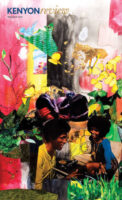
The May/June 2021 issue of the Kenyon Review is now available. This issue features stories by María José Candela, Gina Chung, Maureen Langloss, and Katherine Sharpe; and essays by Sophie Beck, Jonathan Gleason, and Amit Majmudar.

The May/June 2021 issue of the Kenyon Review is now available. This issue features stories by María José Candela, Gina Chung, Maureen Langloss, and Katherine Sharpe; and essays by Sophie Beck, Jonathan Gleason, and Amit Majmudar.
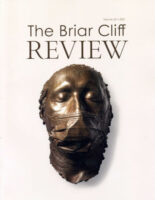
In this issue of The Briar Cliff Review, find poetry by John Blair, Simon Perchik, Twyla M. Hansen, Julie L. Moore, Tony Tracy, Dante Di Stefano, Sarah Fawn Montgomery, Ann Hudson, Michael Hill, Jimmie Cumbie, Alyse Knorr, and more.
An Everyday Cult invites the reader to ride the spiritual rapids of the Center for Transformational Learning, a cult whose leader hopes you will drown. Working under the guise of a trusted therapist, the cult’s aloof, captivating, even sexy leader—referred to only as ‘Doug’—gives weekly ‘homework’ assignments that use pathologies, psychological archetypes, and dream interpretation as the foundations for self-annihilation.
The author’s elegant use of language makes An Everyday Cult read like a literary work of fiction and yet her treatment of the subject matter makes the tale race like a horror film. We watch from behind reluctantly parted fingers as the dark reality of the cult unfolds.
The reader travels with Buglion as she falls—simultaneously in love with the cult’s charismatic leader and asleep to her own identity—drifts, sleeps, and then snaps awake to the eighteen-year nightmare she has endured. The narrative reminds us to open our own eyes and stay awake to the dangers of authoritarian leaders claiming to know us better than we know ourselves.
An Everyday Cult by Gerette Buglion. Rootstock Publishing, May 2021.
Reviewer bio: C. Jane Taylor is the author of Spirit Traffic, a woman’s motorcycle journey of family, fear, and fledging. She lives, writes, and rides in Hinesburg, Vermont.
Buy this book from our affiliate Bookshop.org.
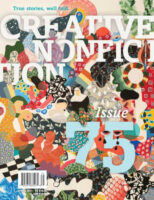
This milestone issue features some of our favorite prizewinning essays. These curious, beautiful, nuanced stories about everything from surviving lightning strikes to the relief of solving medical mysteries consider the many perils, as well as the tremendous power, of living in a body. See what else the issue has in store for you at the Creative Nonfiction website.
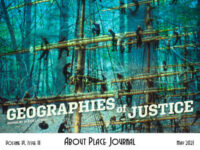
“Geographies of Justice,” edited by Alexis Lathem with Richard Cambridge and Charles Coe. An extraordinary testament to extraordinary times: includes poetry from Susan Deer Cloud, Tammy Melody Gomez, Richard Hoffmann, Jacqueline Johnson, Petra Kuppers, and Danielle Wolffe; nonfiction from Teow Lim Goh, Andréana Elise Lefton, David Mura, Nicole Walker, and Catherine Young. Find more contributors at the About Place Journal website.
Jesse Lee Kercheval’s “The Boy Who Drew Cats” speaks both to our current time and to the necessity of human myth. Confined to a house in Uruguay as her children face quarantine in Japan, Kercheval connects to the hero of a Japanese fable, the titular drawer of cats, in an attempt to find solace within herself through her own artistic ventures.
This connection to cultural myth—and Kercheval does cement her own tale very concretely to the modern as well as the mythical—inspires the author in its assertions of safety, balance, and a sense of stability. The myth helps her recapture her own love of art and facilitates a return to the page where flowers transform into felines. Kercheval does not uphold the myth as a perfect guideline, either—she comments upon it, accepting the good she sees there while acknowledging elements she appears to dislike.
But her inclusion of the fable also speaks to the wider purpose of human myth—as a necessity of the imagination to allow us to “visit” faraway places and to inspire. Kercheval places both within the story to generate trust that the world will get better, as well as trust in her own abilities.
“The Boy Who Drew Cats” by Jesse Lee Kercheval. Brevity, January 2021.
Reviewer bio: Adrian Thomson is a graduate student at Utah State University, currently working toward his MS by way of a thesis in poetry.
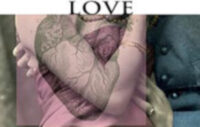
Our theme for this issue is LOVE in all its painful, confusing, passionate, and joyous diversity. Featuring fiction by Louise Blalock, Margaret Emma Brandl, Ed Davis, Stefan Kiesbye, and Nick Sweeney; memoir by Jane Boch, Ruth Askew Brelsford, Laura Foxworthy, and Carmela Delia Lanza; and poetry and prose poems by Leonore Hildebrandt, Robert Murray, and Jacalyn Shelley.
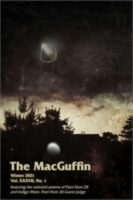
The MacGuffin’s Vol. 37.1 comes at you with an expanded selection of poetry and expanded coverage of our Poet Hunt contest(s) too! We start with Matthew Olzmann’s selections from Poet Hunt 25: Vivian Shipley’s grand prize winning “No Rehearsal” and honorable mention selections from Rita Schweiss and John Jeffire.
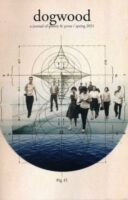
Find the 2021 Dogwood Award Winners in this issue. Also featuring work by Padya Paramita, Ellen Graf, Sheree La Puma, Christine Chen, Anne Hampford, Vanessa Haley, S.M. Ellis, Willie Lin, Cristina Baptista, Emily Polk, and more. Read more at the Dogwood website.
Our spring issue features poems, fiction, and creative nonfiction by Cezarija Abartis, Bryana Atkinson, Robert Erle Barham, Melinda Brasher, Laura Todd Carns, Charlie Clark, and more. See a full contributor list at the Mag Stand.
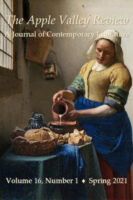
Featuring new fiction by Michael Beadle and Mary Gulino, an essay by Carl Schiffman, and poetry by Linda K. Sienkiewicz, Giovanni Raboni (translated from the Italian by Zack Rogow), Joseph Fasano, James P. Cooper, Katherine Fallon, Barbara Daniels, and Mark Belair. Cover painting by Dutch artist Johannes Vermeer. More info at the Apple Valley Review website.
Guest Post by Madeline Thomas.
When a combination of a Catholic upbringing and the unforgettable viewing of a commercial for The Exorcist sends a young girl’s mind to the inevitability of a personal demon possession, the first steps are taken on a path to parental disappointment. Jessica Power Braun’s “Black Alpaca” places readers at the intersection of religion, generational conflict, and closet-Jesus nightmares with sharp humor and unflinching honesty.
The essay, published in Hippocampus Magazine, works through the realities of fear and guilt in the Catholic Church, the slow movement away from your family’s religious identity, and the discovery of a poignant black alpaca painting in the context of Braun’s identities as a mother, wife, and daughter. Humor forms the heart of the piece, but the essay makes no attempt to pull away from what is both painful and real—forming a balance that cultivates both emotional impact and investment for readers.
In a time where I feel the need for constant breaks from the mire of news and the world in general, the humor and tone present in “Black Alpaca” provides needed relief. Braun utilizes her power in storytelling to craft something worth connecting with.
“Black Alpaca” by Jessica Power Braun. Hippocampus Magazine, January 2021.
Reviewer bio: Madeline Thomas is a graduate student and writer at Utah State University.
In Every Last Breath: A Memoir of Two Illnesses, scholar and memoirist Joanne Jacobson strings twelve independently stunning essays together to create a lyrically compressed contemplation of the always frail body.
The essays detail Jacobson’s heart-wrenching experience of discovering her own chronic illness even as she was writing about her mother’s. Both memoir and biography, the book rejects the linear trajectory of conventional narrative to call the reader “out of time” and into the lives of two Jewish-American women as their diseases, one of blood and one of breath, force them to confront “end of life” together.
With the precision of a poet, Jacobson gracefully and honestly explores the ephemerality of time and breath and speaks deeply to the shared human experience of incremental loss. Every Last Breath is a hopeful and hurting reminder that the body is both singly inhabited and commonly shared.
Every Last Breath: A Memoir of Two Illnesses by Joanne Jacobson. The University of Utah Press, 2020.
Reviewer bio: Kylie Smith is a writer based out of Logan, Utah.
Buy this book from our affiliate Bookshop.org.
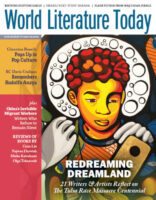
World Literature Today’s spring issue, “Redreaming Dreamland,” gathers the work of 21 writers and artists reflecting on the centennial of the 1921 Tulsa Race Massacre, including Patricia Smith, Joy Harjo, Jewell Parker Rhodes, and Tracy K. Smith. Additional highlights in the issue include a special section on Chinese migrant workers’ literature; an essay on how Giannina Braschi’s work keeps “popping up” in pop culture; fiction from Belarus and Iraq; plus reviews of new books by Najwan Darwish, Cixin Liu, Olga Tokarczuk, and dozens more.
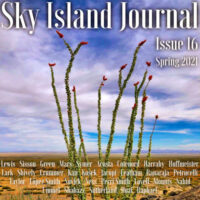
Sky Island Journal’s stunning 16th issue features poetry, flash fiction, and creative nonfiction from contributors around the globe. Accomplished, well-established authors are published—side by side—with fresh, emerging voices. Readers are provided with a powerful, focused literary experience that transports them: one that challenges them intellectually and moves them emotionally. Always free to access, and always free from advertising, discover what over 80,000 readers in 145 countries already know; the finest new writing is here, at your fingertips.
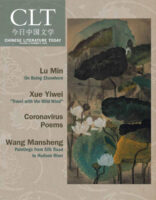
In this issue of Chinese Literature Today: a selection Coronavirus Poems, “On Being Elsewhere” a feature by Lu Min, “Travel with the Wild Wind” by Xue Yiwei, and paintings by Wang Mansheng. Plus, poetry by Haobo Shen, Bai Lin, Zheng Min, and more, and a short story by Zhang Ning.
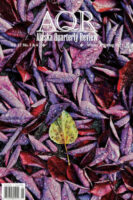
In this issue, find special Memoir as Drama feature “Dialogue Box” by Debbie Urbanski. Also in this issue: stories by Emily Mitchell, Elizabeth Stix, Cara Blue Adams, JoAnna Novak, and more; essays by Emma Hine, Catalina Bode, Nicole Graev Lipson, and Josh Shoemake; and poetry by Emily Nason, Rose DeMaris, Dorsey Craft, and others. Find more contributors at the Alaska Quarterly Review website.
Michael Keenan Gutierrez explores the meaning of truth and the power of fiction in his essay “Lies I’ll Tell My Son.” Gutierrez starts the reader grounded in fact. His great grandfather, Red, was a bookie: “This is true.” Then the details of Red’s life grow murkier. The story of Red winning a WWI draft card in a poker game sounds dramatic enough it might have come from a movie. Red’s birth certificates and draft cards have different dates and names. Gutierrez’s uncle proclaims, “They were all a bunch of fucking liars.”
Gutierrez has heard that we aren’t supposed to lie to children “except about Santa Claus and death.” But what is the purpose of the lies that build such fantastic family lore? The tales are in contrast to a more recent generation that lived “the standard formula of work, retirement, and death.” The lore of Red paints the world as “more magical than a paycheck and a mortgage.”
Gutierrez resolves to tell his son the tales of his family and “shade the truth in fiction.” What about the hard truths about life and death? Well, Gutierrez explains: “I’ll let him figure out heaven on his own.”
“Lies I’ll Tell My Son” by Michael Keenan Gutierrez. 805 Lit + Art, February 2021.
Reviewer bio: Elle Smith is a graduate student at Utah State University.
“We don’t know much about Mr. Otomatsu Wada of Unit B in Barrack 14 in Block 63 of the Gila River Relocation Center,” Eric L. Muller admits at the start of his essay, “The Desert Was His Home.” This lack of knowledge does not deter Muller from examining the pain and power of absence, as well as how deep research becomes an avenue for creative discovery.
Throughout this essay, Muller lays out the facts about this one Japanese-American, among many, held prisoner in the U.S. during World War II. Muller uses what little is known of this man to sketch out a rough but potent portrait of his life. Most notable was Wada’s “two-year-old mystery” marked by the refrain “We don’t know” that Muller uses until Wada’s fate is revealed.
This essay demonstrates how seamlessly and naturally a story can incorporate the many don’t knows and can’t knows inevitable in research. It is even possible, as “The Desert” shows us, how the gaps in a subject’s life can become the story. This piece can be found in Issue 74 of Creative Nonfiction.
“The Desert Was His Home” by Eric L. Muller. Creative Nonfiction, Winter 2021.
Reviewer bio: Mark Smeltzer is a graduate student in Utah State University’s English Department. His area of specialization is in poetry.
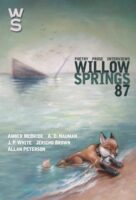
Willow Springs 87 features prose and poetry from Joseph Millar, Ramona Ausubel, Jessica Lee Richardson, Andrew Furman, Lawrence Lenhart. Plus, John-Michael Bloomquist, Todd Davis, and others.
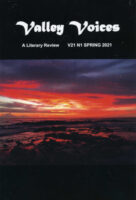
The Spring 2021 issue includes a special feature with work by Jim Kacian. In this section, John Zheng also interviews the poet. New prose by Ted McCormack, Sierra Tribbett-Collins, Khem K. Aryal, and DC Berry. Poetry by K. S. Hardy, and more.
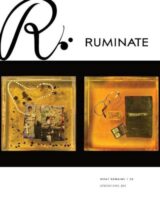
From the editors: In the face of the immense grief that surrounds us, for this issue Ruminate Magazine editors decided to explore What Remains. “Everything is held together with stories,” writes the acclaimed author Barry Lopez, who died this past year, a few months after the Holiday Farm Fire destroyed his house and archives. “That is all that is holding us together. Stories and compassion.” This issue features the winners of our 2020 Broadside Poetry Prize: Michael Dechane and S. Yarberry.
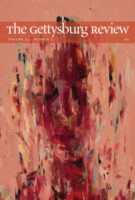
In the latest issue of The Gettysburg Review: essays by Kate Lebo, Chad Davidson, Michele Battiste, Jen Silverman, and Maya Jewell Zeller; fiction by David Crouse, Lilly Schneider, and Melanie Ritzenthaler; and poetry by John Sibley Williams, Alice Friman, Kathryn Smith, and others.
In the 35th-anniversary edition of the San Francisco-based literary magazine ZYZZYVA, Lauren Markham’s essay, “Cathedrals of Hope,” reminisces on the women’s suffrage movement. This piece is timely as 2020 America marked the centennial anniversary of women gaining the right to vote. Markham not only reflects on the women who sacrificed their freedom and endured abuse so that women can vote today but also discusses populations forgotten in the 1920s: men and women of color.
Markham weaves her own narrative into the larger historical picture, describing how her first-time voting was marked with devastation when George Bush Jr. won—again. Markham takes a unique look at where we as Americans are in regard to democracy while commentating on where we came from. Markham writes, “How easy human beings can forget the people who came before us, and the debts we owe.”
“Cathedrals of Hope” by Lauren Markham. ZYZZYVA, 2020.
Reviewer bio: Holly Vasic is a Graduate Instructor seeking a Master’s in Folklore at Utah State University with an undergrad in Journalism.
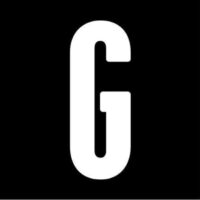 Guest Post by Andrew Romriell.
Guest Post by Andrew Romriell.
In “White Witchery,” from Guernica, Elissa Washuta offers fierce insight into the varied and complex ways whiteness has plundered Indigenous bodies and beliefs. Here, Washuta offers difficult truths surrounding colonialism and settler violence alongside the strength of her own perseverance.
Growing up in a “heavily Catholic, forest-and-farmland slice of New Jersey,” Washuta found a sincere desire to make magic, to be a witch who “brings change to the seen world using unseen forces.” To Washuta, magic became a way of finding stability within the uncontrollable world surrounding Native women in America, an America where, Washuta describes, “[colonizers whisper] that I’m not wanted here, not worthy of protection, nothing but a body to be pummeled and played with and threatened into submission.” Yet, through magic, her own tenacity, and the communal strength she finds in a women’s spiritual circle, Washuta says, “ My whole body is a fire” and “I have not died yet.”
“White Witchery” grants a rare and vulnerable insight into the capitalistic industry of the United States, the pop-culture surrounding self-care and self-healing, and the internal struggle of surviving a colonized America as a Native woman, a woman with “nothing now but my big aura, my fistful of keys, and my throat that still knows how to scream because no man has succeeded in closing it.” Though the journey Washuta takes us on is not an easy one, it is one of the most compelling, vulnerable, and important ones we can take.
“White Witchery” by Elissa Washuta. Guernica, February 2019.
Reviewer bio: Andrew Romriell is an avid writer, teacher, and student who is passionate about experimental forms, research-based writing, and intersections of genre. Learn more at ajromriell.com.
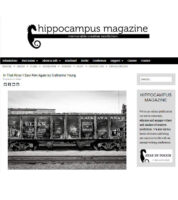 Guest Post by Kelsie Peterson.
Guest Post by Kelsie Peterson.
Catherine Young’s essay, “In That River I Saw Him Again,” published online in November 2020 by Hippocampus Magazine, reads like a coal train passing by you. It is full of glimpses of beauty and wonder, as well as the past, with a poetic through line that moves like the “shadows” Young describes. Using the imagery of coal trains from her childhood, photographs, and early motion pictures, Young’s essay wonders at the idea of memory, of life, and of those lost in her childhood.
The central question running through this essay is, “What can the heart remember?” Young invites readers to discover an answer with her as moving pictures first allow her father to come alive once more, and then ultimately, her uncle. Young’s writing offers a unique and engaging perspective on the life of memory.
What engaged me most as a reader was this piece’s inventive use of engaging imagery and repetition of poetic meditations. The reading experience mirrored that of a train passing or of the flicker of the early motion picture. The flashes of ideas flowed together in a truly unforgettable piece.
“In That River I Saw Him Again” by Catherine Young. Hippocampus Magazine, November 2020.
Reviewer bio: Kelsie Peterson is completing her last semester at Utah State University and will graduate with her MS in English.
Guest Post by Natalie Hess.
This book was absolutely phenomenal and it was a 5-star read! It dealt with mental health, specifically anxiety and depression, in such a fun way. I burst out laughing so many times that people would actually give me weird looks or ask what was happening. Jenny Lawson is just so funny and she somehow combines this humor with her terrible experiences to create the intriguing, hilarious, inspiring masterpiece that is Furiously Happy. There are lighthearted parts, and there are parts that are really serious and it all balances out perfectly.
This book did leave me with more questions than answers, but it definitely made me think about how “normal” my life seems compared to hers. I also learned that both of those lives are perfectly acceptable.
To anyone who is struggling with mental health, this could definitely help you, and even if it doesn’t you will probably still enjoy it nonetheless. I know I did.
Furiously Happy: A Funny Book About Horrible Things by Jenny Lawson. Flatiron Books, February 2017.
Reviewer bio: I’m Natalie Hess and I’m simply a high school student who LOVES reading everything from scifi to romance to nonfiction and everything in between. I also love sharing my thoughts and I hope you enjoy!
Buy this book from our affiliate Bookshop.org.
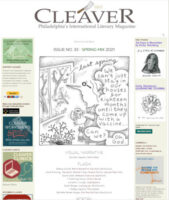
Welcome to the Spring 2021 issue of Cleaver featuring a visual narrative by Jennifer Hayden; flash by Rebecca Entel, David Galef, Gabby Capone, and others; poetry by Ann de Forest, Laura Tanenbaum, Valerie Loveland, James Miller, and Kate Peterson.
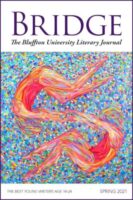
The Best Young Writers Age 14-24. These young writers and artists are deeply engaged—both with timeless themes and with their contemporary iterations and manifestations. Fiction by Michaela Crawford, Mac Bowers, Jonah Bradenday, Jacob C. Connerly, and Alexa Bocek. Nonfiction by Jessica Baker. Find more contributors at the Bridge website.
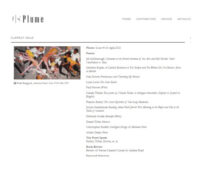
For this month’s Plume featured selection, Nancy Mitchell interviewed five Poet Laureates: Tina Chang, Elizabeth Jacobson, Paisley Rekdal, Levi Romero and Laura Tohe. In nonfiction: “Correspondence In The Air” by Ilya Kaminsky and “Twilight of the Theorists” by Doug Anderson. Andrea Read reviews Steven Cramer’s Listen.
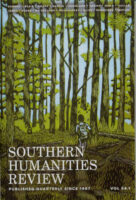
Nonfiction by Jade Hidle and Emily Waples; fiction by Remy Barnes, Christine Ma-Kellams, Raquel Olive, and Keija Parssinen; and poetry by John Blair, Asa Drake, Giles Goodland, Aiden Heung, Patrick Holian, Avery K. James, David Klose, and Rooja Mohassessy. Find more info at the Southern Humanities Review website.
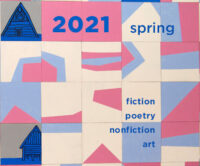
The Spring 2021 issue of The Writing Disorder features fiction by Alison Bullock, Jennifer Makowsky, Robert Collings, Wendy Maxon, and more; poetry by R.T. Castleberry, Nicholas Karavatos, Mark DuCharme, Natasha Sharma, Hana Jabr, and John Tustin; nonfiction by Katy Wright, Riley Winchester, and Donna D. Vitucci. Art by Stewart Francis Easton.
 Guest Post by Christopher Nicholson.
Guest Post by Christopher Nicholson.
The best friend I ever had was my dog Milo. He offered the best kind of love—not unconditional but predicated on the most reasonable conditions. I had to earn his love and could feel good about that, but he didn’t expect me to be perfect. This sensation is nothing new to most people who have had a pet.
In “Honey, I’m Home: Beyond the Rescue Door,” published in the Fall/Winter 2020-2021 edition of Magnets and Ladders, Bonnie Blose reminisces on sharing such a love with the titular cat, Honey, who found her at a local rescue shelter and chose her immediately. Honey had some traumatic experiences in her past that affected her behavior and didn’t make her an easy pet. Blose committed from the very beginning to give her the love she needed, no matter what, for however much time they had together. She did exactly that.
Blose extols her cat’s intelligence and emotion, painting her as almost human—or as Blose would insist, better than human. This is also a relatable mindset for me and other past or present pet owners. They are not mere accessories; they are our friends, our family, our confidantes. Honey shows as much personality in the story as any human character, and one senses that it’s true to life, that Blose isn’t just anthropomorphizing her for dramatic purposes.
Magnets and Ladders is an online magazine for writers with disabilities, and this story won first place in the nonfiction category of the National Federation of the Blind Writers’ Division’s 2020 contest, so the author’s disability is a constant subtext without ever being stated outright in the story. One gets the impression that Blose needed Honey as much as Honey needed her, that their relationship was symbiotic in a way. Many people are so preoccupied with finding romantic companionship to “complete” themselves that they overlook the potential of pets—but in this time when human connection is so limited, they may rediscover an appreciation for the one-of-a-kind bonds that animals can offer.
Take a few minutes, open your heart, and give this story a chance.
“Honey, I’m Home: Beyond the Rescue Door” by Bonnie Blose. Magnets and Ladders, Fall/Winter 2020-2021.
Reviewer bio: Christopher Nicholson is an English 1010 instructor and Creative Writing graduate student at Utah State University. He writes and blogs about all kinds of things at https://www.christopherrandallnicholson.com.
“When the butterfly struggles out of its pupa, for three long hours its wings are wet and as utterly useless as a newborn’s hands.”
In “Life Inside,” found in Issue 211 of Cimarron Review, author Caroline Sutton contemplates the limitations of mortality and motherhood amid the upcoming birth of her first granddaughter. Sutton ingeniously weaves the eager experiences of her pregnant daughter with the vulnerable life cycle of monarch butterflies and their fruitless efforts for survival in a hostile world.
Reflecting on her own complicated pregnancy decades before, Sutton likens the near loss of her infant to the toxic consumption of milkweed leaves. Monarch mothers lay eggs on milkweed plants and milkweed plants alone, for when monarch larvae ingest the plant’s toxic properties, predators avoid the black and yellow creature. Sutton thinks back to her traumatic delivery and questions her blind trust during the delivery, her assumptions that everything would be alright because it always was, because mothers always offered protection. But, in a world strung with chaos and turmoil, perhaps there are some obstacles a mother cannot predict.
Sutton concludes by comparing her daughter’s upcoming delivery with a caterpillar’s metamorphic emergence. Rather than reflecting on the cliché symbol of hope, Sutton contemplates the feebleness of the new creature. Its wings, wet, useless, and unable to defend against predators looking to “attack and devour the butterfly, toxins and all, before the wings ever open fully.” Although monarch mothers provide protection from larvae to pupa, they cannot predict the perils awaiting beyond the chrysalis.
“Life Inside” by Caroline Sutton. Cimarron Review, Spring 2020.
Reviewer bio: Mia Jensen is a graduate student at Utah State University studying creative writing. She loves horror novels, trail running, and her Australian Shepherd.
How many tree whispers and shouts can you hear? How many mysteries and histories are there in wood and water, bird and human, ice and insect? How much do you like to travel? Go with George David Haskell to explore these questions and many others. He takes us far beyond tree rings and photosynthesis, far below roots and above crowns, though we visit those too when we read of his forest adventures around the world as a researcher and teacher of biology and environmental studies.
Listening to Haskell’s lush language, alive with many forest voices—maples and green ash in suburbs and forests, and Sabal palm forest in Georgia dunes—we attune to the wonders of our own senses of sound and touch and sight. Trees have developed their own suite of senses: They sense when water is fresh or salt and know how much to take up and conserve. How to shorten and wax-coat leaves in dry climates.
We meet individual trees and hear their rhythms throughout a year and into their afterlife. That afterlife is part of the larger symphony of nature, where the sounds and touches and sights include every sentient creature’s life and afterlife.
From an Amazon forest preserve in Ecuador where the ceibo tree is a living deity, through Echizen, capitol of Japanese artisan wood paper, with stops in New York City to listen to street trees, to the Florissant Fossil Beds in southern Colorado, and to other places with their own tree songs, Haskell writes the music of trees in a language that allows us to tune into the symphony of terrestrial life.
The Songs of Trees: Stories from Nature’s Great Connectors by David George Haskell. Penguin Random House, April 2018.
Reviewer bio: Carolyn is a poet and a Soto Zen priest who leads art and meditation retreats and workshops. She lives in Santa Cruz, California.
Buy this book from our affiliate Bookshop.org.
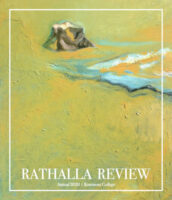
This annual issue of Rathalla Review is comprised of the best work from the Spring and Fall issues during the pandemic. In these pages, we showcase the best poems, essays, stories, and art we received during a time when all our lives were changing. Gale Acuff, Jay Julio, Bina Ruchi Perino, David Wright, and more.
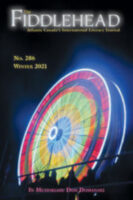
The Winter 2021 issue of The Fiddlehead features creative nonfiction by Chafic LaRochelle, Jen Ashburn, and Emira Tufo; fiction by Elise Thorburn, Liz Johnston, Dylan Taylor, and more; and poetry by Don Domanski, Rosebud Ben-Oni, Phoebe Wang, Keith Taylor, Rose Maloukis, LN Woodward, Monica Rico, and more.
In “She,” published in Issue 18 of Into the Void, author Grace Camille begins with an inventory of the things that the she has chosen to hold onto. Through the memories the objects invoke, we are introduced to the narrator’s own addiction, a need to belong, to be a part of something and to nurture “a proper addiction” that “began as a Hail Mary plan to be accepted by sleek, serious coworkers.”
Camille’s loneliness becomes our loneliness through the use of the third person, creating an emotional distance from events that still allows the reader to recognize. When she meets “him,” he makes her feel needed, wanted. When he leaves for the Peace Corps, the world becomes one of routines. “She jogs in the evenings, washes her hair weekly, flosses daily, eats sometimes,” and the list goes on. One-hundred-and-three days later, she’s still wishing after him, remembering him and longing for what she cannot hold. While she “reaches for his hand,” he is “reaching for a firefly,” revealing the futility of trying to hold onto that which does not wish to be held.
“She” by Grace Camille. Into the Void, 2021.
Reviewer bio: Tyler Hurst is a graduate student at Utah State University studying creative writing while completing his last semester there.
In Pain Studies, published in 2020 by Bellevue Literary Press, Lisa Olstein explores her relationship between pain and chronic migraines with the simple statement that “all pain is simple. And all pain is complex. You’re in it and you want to get out.”
From there Olstein takes readers through the explorations and complexities of pain by connecting pain to language, medical dramas, translations, and surprisingly, Joan of Arc. Readers will see echoes and references of Eula Biss’s lyric essay “The Pain Scale,” as well as references to the works of the poet and translator Anne Carson, among other poets. Olstein asks readers to consider migraine as “a particular version of the present. What happens when its present becomes yours for extended periods of time, for a significant portion of your life?”
Pain Studies by Lisa Olstein. Bellevue Literary Press, March 2020.
Reviewer bio: Kayla Berryman is a graduate student at Utah State University.
Buy this book from our affiliate Bookshop.org.
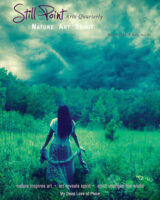
This issue’s theme is “My Deep Love of Place.” Featured writers include Melodie Corrigall, Suzanne Finney, Catherine Young, Amy Cotler, Jeri Ann Griffith, Lawrence Gregory, Sue Schuerman, Cayce Osborne, Penny Milam, David Denny, William Bless, Barbara Cole, Rosalie Sanara Petrouske, and Teresa H. Klepac. Featured artists include Catherine L. Schweig, Walt Hug, Birgit Gutsche, MJ Edwards, and Barbara Anne Kearney. Find more info at the Still Point Arts Quarterly website.
The March-April 2021 issue of Hippocampus Magazine is now at the Mag Stand, and it’s full of CNF goodness for you, including work by Scott Bane, Paul Crenshaw, Bethany Kaylor, Anya Liftig, Francisco Martinezcuello, Tiffany Mathewson, Sheila Monaghan, Jim Ross, Michelle Strausbaugh, Kareem Tayyar, and Lish Troha. Also in this issue: a book review by Emily Dillon, a craft essay by Michelle Levy, and Robin Wheeler on “Going Mobile.”
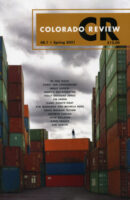
The Spring 2021 issue features nonfiction by Molly Rogers; fiction by Kathryn Harlan; and poetry by Genevieve Payne, T. Dallas Saylor, and Emma Lewis. Also in this issue: Tim Erwin, Holly Goddard Jones, Monica Macansantos, and more. See other contributors at the Colorado Review website.
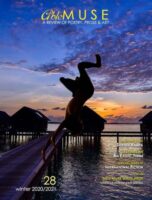
This issue’s themed art exhibit is “Exotic,” and our featured poet is “Stephen Kampa,” interviewed by Chelsea Woodard. Other poets in this issue include Tim McGrath, John Beaton, Richard Cecil, Estill Pollock, Bruce Bennett, Anne Delana Reeves, Elise Hempel, Terese Coe, Verga Ignatowitsch, Dan Campion, and others. Plus, a selection of book reviews; essays by N.S. Thompson and Christopher Rivas; and an international fiction special feature. See more contributors at the Able Muse website.
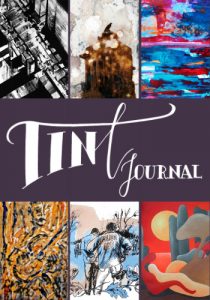
A new Tint Journal is out. Read 25 new literary creations by ESL writers from all around the world online and for free at our website. Each text is accompanied with visual art creations by international artists, and many feature audio recordings of the writers reading their work. The 25 new poems, short stories and essays by writers identifying with 19 different nationalities and speaking 18 different mother tongues are just as diverse in their subject matter: Ranging from immigration, food, loss, LGBTQ+ and race to horror and romance, they will cue readers to think about the pressing issues of our time and open new literary landscapes to enjoy.
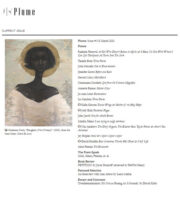
This month’s Plume featured selection includes an interview with Ann Arbor by Leeya Mehta with a selection of work by the poet. DeWitt Henry reviews Petition by Joyce Peseroff. In nonfiction: “Overdetermination (It’s Not as Boring As It Sounds)” by David Kirby.
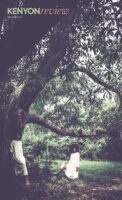
In addition to the 2020 Short Nonfiction Contest winners, Miriam Grossman, Mary O. Parker, and Stella Li, the Mar/Apr Kenyon Review includes “Nature’s Nature,” our seventh annual special poetry section centered on “nature, the environment, and ecological witness,” as Poetry Editor David Baker describes it in his introduction.
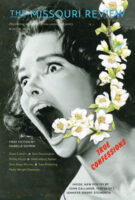
Inside the latest issue of Missouri Review: first fiction from Isabelle Shifrin. Featuring poetry by John Gallaher, Jennifer Sperry Steinorth, and Teresa Ott, fiction by Drew Calvert, Yxta Maya Murray, Mehr-Afarin Kohan, and Sam Dunnington, essays from Molly Wright Steenson and Phillip Hurst, and more, including a Curio Cabinet piece on Hans Christian Andersen.
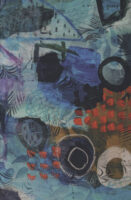
In this issue of Gargoyle: family and relationship works, a thread of Greek myths, bullies, and a couple NASA poets. Nonfiction by Anne McGouran, Frances Park, Marilyn Stablein, and D. E. Steward; fiction by Sean Gill, Frederick Highland, Len Kruger, Jillian Oliver, Max Talley, Curtis Smith, and more; and poetry by CL Bledsoe & Michael Gushue, Roger Camp, Kathleen Clancy, German Dario, Holly Day, Alexis Draut, Robert Estes, Michelle Fenton, and others.
Leo Touchet is an American photographer who has traveled to over fifty countries to photograph for corporate publications and national and international magazines including Life, Time, National Geographic, New York Times, Der Stern, Panorama, and Popular Photography.
Touchet’s interest in photography sprouted as a high school photographer. In the early 1960s he lived in Greenwich Village and maintained his interest by studying the archived photographs of Henri Cartier-Bresson, Paul Strand, Eugene Smith, Edward Steichen, and Gordon Parks in the Museum of Modern Art. In Rochester, New York, Touchet met Beaumont Newhall, then director of the George Eastman House Museum and bought a used Leica M3 from him. His meeting with Joan Liftin, a photo editor at the United Nations, was a turning point in his career. Liftin convinced him to be a full-time photographer, and then he hopped on the plane to Saigon, Vietnam for his first foreign trip as a photographer. Continue reading “People among Us: Leo Touchet’s Collection of Photographs”